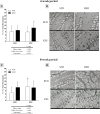Physical activity prevents alterations in mitochondrial ultrastructure and glucometabolic parameters in a high-sugar diet model
- PMID: 28199417
- PMCID: PMC5310863
- DOI: 10.1371/journal.pone.0172103
Physical activity prevents alterations in mitochondrial ultrastructure and glucometabolic parameters in a high-sugar diet model
Abstract
Endurance exercise is a remarkable intervention for the treatment of many diseases. Mitochondrial changes on skeletal muscle are likely important for many of the benefits provided by exercise. In this study, we aimed to evaluate the effects that a regular physical activity (swimming without workload) has on mitochondrial morphological alterations and glucometabolic parameters induced by a high-sugar diet (HSD). Weaned male Wistar rats fed with a standard diet or a HSD (68% carbohydrate) were subjected to 60 minutes of regular physical activity by swimming (without workload) for four- (20 sessions) or eight-week (40 sessions) periods. After training, animals were euthanized and the sera, adipose tissues, and skeletal muscles were collected for further analysis. The HSD increased body weight after an 8-week period; it also increased the fat pads and the adipose index, resulting in glucose intolerance and insulin resistance (IR). Transmission electron microscopy showed an increase in alterations of mitochondrial ultrastructure in the gastrocnemius muscle, as well as a decrease in superoxide dismutase (SOD) activity, and an increase in protein carbonylation. Regular physical activity partially reverted these alterations in rats fed a HSD, preventing mitochondrial morphological alterations and IR. Moreover, we observed a decrease in Pgc1α expression (qPCR analysis) in STD-EXE group and a less pronounced reduction in HSD-EXE group after an 8-week period. Thus, regular physical activity (swimming without workload) in rats fed a HSD can prevent mitochondrial dysfunction and IR, highlighting the crucial role for physical activity on metabolic homeostasis.
Conflict of interest statement
Figures






Similar articles
-
Thyroid hormone activation by type 2 deiodinase mediates exercise-induced peroxisome proliferator-activated receptor-γ coactivator-1α expression in skeletal muscle.J Physiol. 2016 Sep 15;594(18):5255-69. doi: 10.1113/JP272440. Epub 2016 Aug 18. J Physiol. 2016. PMID: 27302464 Free PMC article.
-
Endurance training blocks uncoupling protein 1 up-regulation in brown adipose tissue while increasing uncoupling protein 3 in the muscle tissue of rats fed with a high-sugar diet.Nutr Res. 2012 Sep;32(9):709-17. doi: 10.1016/j.nutres.2012.06.020. Epub 2012 Sep 28. Nutr Res. 2012. PMID: 23084644
-
Wheat germ supplementation alleviates insulin resistance and cardiac mitochondrial dysfunction in an animal model of diet-induced obesity.Br J Nutr. 2017 Aug;118(4):241-249. doi: 10.1017/S0007114517002082. Br J Nutr. 2017. PMID: 28875871
-
Exercise training attenuates lipectomy-induced impaired glucose tolerance in rats.Endocr Regul. 2009 Jul;43(3):107-16. Endocr Regul. 2009. PMID: 19817505
-
Treating fructose-induced metabolic changes in mice with high-intensity interval training: insights in the liver, white adipose tissue, and skeletal muscle.J Appl Physiol (1985). 2017 Oct 1;123(4):699-709. doi: 10.1152/japplphysiol.00154.2017. Epub 2017 May 11. J Appl Physiol (1985). 2017. PMID: 28495843
Cited by
-
Potential regulatory role of PGC-1α within the skeletal muscle during metabolic adaptations in response to high-fat diet feeding in animal models.Pflugers Arch. 2024 Mar;476(3):283-293. doi: 10.1007/s00424-023-02890-0. Epub 2023 Dec 4. Pflugers Arch. 2024. PMID: 38044359 Free PMC article. Review.
-
Are Alterations in Skeletal Muscle Mitochondria a Cause or Consequence of Insulin Resistance?Int J Mol Sci. 2020 Sep 22;21(18):6948. doi: 10.3390/ijms21186948. Int J Mol Sci. 2020. PMID: 32971810 Free PMC article. Review.
-
Intense Caloric Restriction from Birth Protects the Heart Against Ischemia/Reperfusion Injury and Reduces Reactive Oxygen Species in Ovariectomized Rats.Antioxidants (Basel). 2025 Jan 31;14(2):169. doi: 10.3390/antiox14020169. Antioxidants (Basel). 2025. PMID: 40002357 Free PMC article.
-
Cardiometabolic and Cellular Adaptations to Multiple vs. Single Daily HIIT Sessions in Wistar Rats: Impact of Short-Term Detraining.Metabolites. 2024 Aug 14;14(8):447. doi: 10.3390/metabo14080447. Metabolites. 2024. PMID: 39195543 Free PMC article.
-
High-glucose diets induce mitochondrial dysfunction in Caenorhabditis elegans.PLoS One. 2019 Dec 17;14(12):e0226652. doi: 10.1371/journal.pone.0226652. eCollection 2019. PLoS One. 2019. PMID: 31846489 Free PMC article.
References
-
- Guran T, Bereket A. International epidemic of childhood obesity and television viewing. Minerva Pediatr. 2011;63(6):483–90. - PubMed
-
- Bluher S, Schwarz P. Metabolically healthy obesity from childhood to adulthood—Does weight status alone matter? Metabolism. 2014. - PubMed
-
- Joslowski G, Goletzke J, Cheng G, Gunther AL, Bao J, Brand-Miller JC, et al. Prospective associations of dietary insulin demand, glycemic index, and glycemic load during puberty with body composition in young adulthood. Int J Obes (Lond). 2012. - PubMed
MeSH terms
Substances
LinkOut - more resources
Full Text Sources
Other Literature Sources
Research Materials

